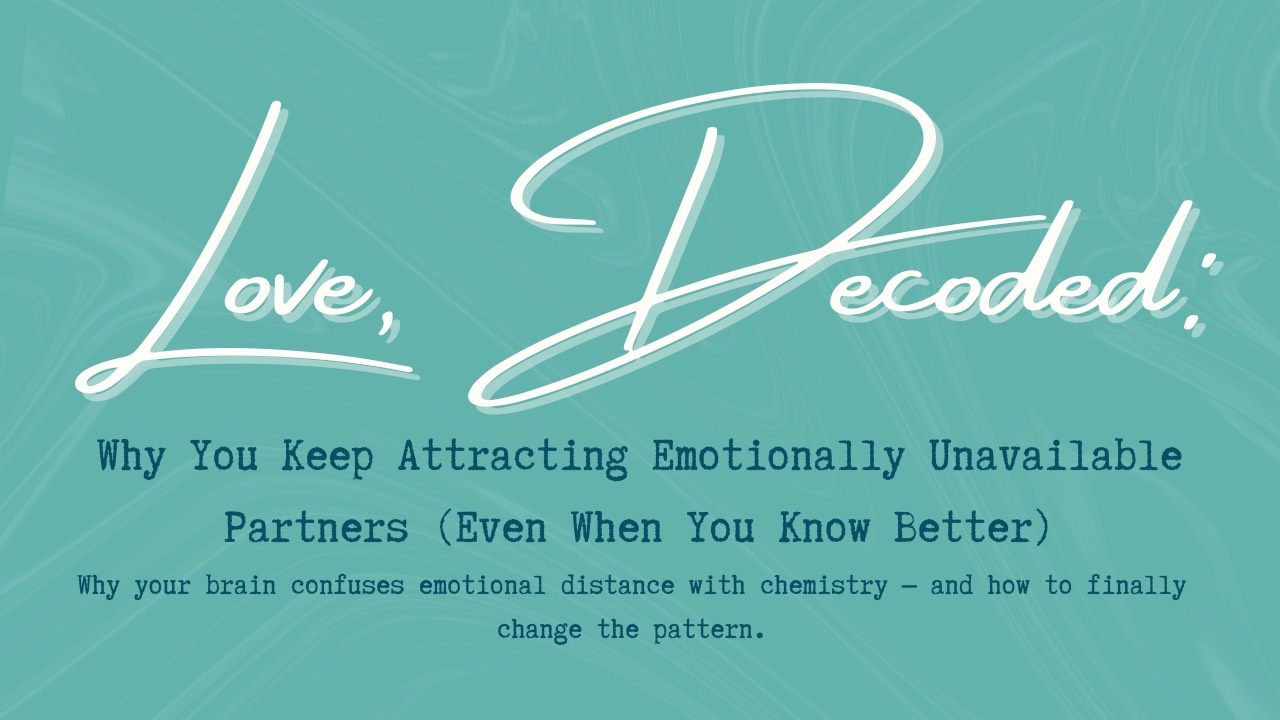
Why You Keep Attracting Emotionally Unavailable Partners (Even When You Know Better)
Oct 23, 2025Here's why your brain confuses emotional distance with chemistry — and how to finally change the pattern.
You promise yourself never again.
No more chasing mixed signals.
No more decoding cryptic texts or convincing yourself that “maybe they’re just busy.”
And yet… here you are again — overthinking a message that never came, feeling that familiar ache in your chest, wondering how someone so emotionally distant managed to feel so right.
You’re not naive. You’re not addicted to drama.
You’re caught in something much deeper — the psychology of familiar love.
💬 A Story You Might Recognise
Take Sophie. She’s 34, smart, self-aware, and the friend everyone calls for advice.
After a string of relationships that left her feeling invisible, she swore she’d only date people who were emotionally mature.
So when she met Dan — calm, grounded, kind — she thought, finally.
But within weeks, she felt restless. He didn’t text constantly. He wasn’t unpredictable. He didn’t create that adrenaline rush she’d mistaken for chemistry.
Meanwhile, a charming but distant ex resurfaced… and her body lit up.
Heart racing. Butterflies. That intoxicating hit of intensity.
It wasn’t love. It was familiarity.
🧠 The Psychology Behind the Pattern
1. Repetition Compulsion: The Brain’s Replay Button
Sigmund Freud first described our tendency to unconsciously recreate old emotional experiences in new relationships — not because we like pain, but because we’re trying to master it.
If you grew up learning that love felt uncertain, inconsistent, or hard to earn, your nervous system logged that as “normal.”
So when you meet someone who feels emotionally unavailable, your body recognises the sensation — and whispers: home.
Your adult self says, “this isn’t healthy.”
But your subconscious says, “this feels familiar.”
2. Attachment & Avoidance: The Push-Pull Cycle
When we attach to someone who can’t meet our emotional needs, our attachment system flips into overdrive.
The more distant they become, the more activated we feel.
It’s not that we want the chase — it’s that our brains link anxiety with connection.
Healthy, secure partners often feel “boring” at first because they don’t trigger that same cortisol-driven spark.
They don’t disappear to make you miss them or leave you decoding silence.
Learning to value calm consistency takes time — and practice.
3. Familiarity Bias: Why Safety Feels Wrong (At First)
Our brains are wired to equate familiar with safe — even when the familiar thing hurts us.
So emotional distance can feel magnetic, while genuine availability feels off-key.
It’s why someone’s warmth might make you freeze up, or why you pull away when things start to feel too stable.
Your body’s alarm system doesn’t yet know the difference between “comfortable” and “dangerous.”
That can be retrained — but it starts with awareness.
4. The Nervous System’s Role: Your Body Keeps the Score
This isn’t just psychology — it’s physiology.
When you’ve lived in fight-or-flight for years, your baseline state becomes hyper-alert.
You feel alive when things are uncertain, and numb when they’re peaceful.
So when a healthy person shows up, your nervous system doesn’t release the usual chemical cocktail of adrenaline and dopamine — and your brain mistakes the absence of chaos for the absence of passion.
🌱 The Turning Point
Real change starts when you stop asking “What’s wrong with me?”
and start asking, “What does this pattern protect me from?”
Because patterns always serve a purpose — even the painful ones.
They keep you from sitting in vulnerability, from risking rejection, from confronting that ancient ache of never feeling chosen.
When you recognise that, the shame starts to dissolve.
And from there, you can begin to rewrite your love template.
💫 How to Rewire Your Relationship Template
1. Learn the Difference Between Spark and Safety.
Next time you feel an intense pull toward someone, pause.
Ask: Is this excitement — or anxiety?
The two can feel nearly identical, but one is rooted in fear of loss, the other in genuine connection.
2. Slow Down the Timeline.
Emotional availability reveals itself over time, not in intensity.
Give yourself permission to take things slowly — not to test the other person, but to regulate your own body’s pace.
3. Reconnect with Your Body’s Signals.
When you feel drawn to someone, notice your body:
Tense jaw? Racing heart? Butterflies that feel like nausea?
That’s your nervous system recalling an old love story.
Breathe. Ground. Remind yourself: Safe love doesn’t rush.
4. Redefine What Chemistry Means.
Healthy chemistry is steady, not spiky.
It’s laughter that feels easy. Eyes that stay kind.
It’s not fireworks — it’s a steady flame that keeps you warm.
5. Keep Choosing Yourself First.
Every time you walk away from someone who can’t meet you emotionally, you’re not being “picky.”
You’re reinforcing your new pattern: I don’t chase love. I receive it.
🌤 The Transformation
Sophie’s story doesn’t end with another heartbreak.
It ends with her noticing — really noticing — how calm her body feels around someone safe.
No adrenaline. No guessing games. Just quiet warmth.
At first, that peace felt awkward — like walking on land after years at sea.
But with time, she realised: this is what secure love feels like.
And one day, that calm started to feel like home.
💌 Your Next Step
If you’re reading this thinking, that’s me, you’re not alone — and you’re not broken.
You’re simply rewiring patterns that took years to build.
💡 Take the Clarity Check-In Quiz to uncover which stage of your relationship recovery journey you’re in, and what your next step toward healthy, available love looks like.
Stay in the loop!
Get psychology-backed relationship tips straight to your inbox.
We hate spam. We will never sell your information, for any reason. By subscribing to The Clarity Drop Newsletter, you also agree to receive occasional updates and marketing. We will only send things that would be genuinely useful to you. Unsubscribe at any time.

